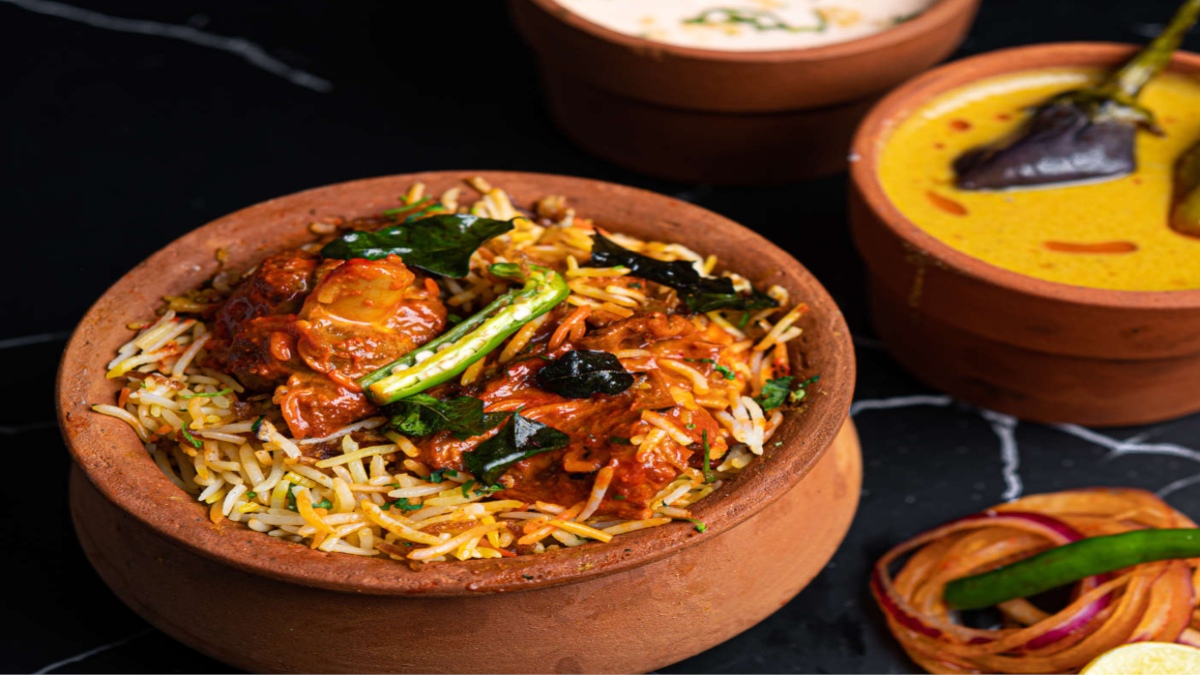For some of us, the word ‘biryani’ takes us to another world. A good biryani is a meal that is satisfying in every possible way since it ignites all our senses, especially if eaten by hand in a traditional way. Being a traveler since childhood, pilafs and biryanis in different geographical locations have been a staple as these are some of the safest, nutritious and wholesome things to consume on the go. Some of those biryanis have been truly memorable and their taste has stayed with me forever.








Delhi has never boasted of a fabulous biryani (and rightfully so) because so far there hasn’t been much to boast of really. We’ve always drooled over the delicate and aromatic Lucknowi or Kolkata biryani or the full-bodied and amazing Hyderabadi, Ambur or Malabari biryani or the flavourful Bombay, Saoji, Memoni or Sindhi biryani. In the capital city, our choices for a good biryani are limited to a few players with none that one could write home about—till now.
The pandemic has not only brought a boom in the cloud kitchen space, but it has also turned the city into a hub of innovation for passionate foodies. We are witnessing an unprecedented variety at this time and I am pleasantly surprised by both the way in which innovation is happening in the F&B space and the way people are taking to it!
While I love a good, traditional Kolkata or Ambur biryani, which I never miss when I’m travelling to those cities, I am quite impressed and taking to the new, innovative biryanis that the capital city now has to offer. Here are my picks:
The Laal Maas Biryani by chef Sahil Singh at his new venture called VDeliver.com. Chef Singh is doing a variety of absolutely stunning biryanis like the Ghee Roast Biryani, the Chicken 65 Biryani, the Laal Maas Biryani and the Rogan Josh Biryani. However, my picks are the amazing Laal Maas Biryani, which packs a punch with the taste of all the flavours of the rice and spices along with that of the traditional Rajasthani dish, and the Ghee Roast Mutton Biryani, which gives me a taste of Mangalore. Both are distinctly different and full-bodied dishes with lots of spices and flavours. The latter is made by using long grain basmati chawal cooked on dum, layered with chicken cooked in the Mangalorean ghee roast masala, flavoured with tempered curry leaves and chillies, and the former is a typical Rajasthani spicy and hot laal maas prepared with yogurt, Mathania chillies and lots of garlic, layered with long grain basmati rice. It is then finished with dhungar, an ancient technique of smoking and infusing the flavour of burnt charcoal smoke into a dish. Both these biryanis are spicy and hot too, and go best with a tomato or cucumber raita since there’s a lot of onion in the biryani already.
The Zafrani Mutton Biryani by Sanjana Adhlakha is an aromatic, light biryani made with Golden Sela rice instead of the basmati as it was made traditionally by her mother. She says, “The method of layering includes zaffran milk and mutton curry along with the rice. The yellow colour in the biryani comes almost entirely from the kesar and not food colouring. This is what makes this dish so special.” The best part about this zaffrani biryani is that the flavours take me back to the taste of the amazing pilafs, sans the dried fruits, of the Mediterranean which I had during my growing up years.
Apparently, Delhi does have a ‘real’ Mughlai-style biryani, unlike what we have been used to eating at various outlets across the country who only claim to serve ‘authentic’ Mughlai cuisine. The use of saalan and achaar masala or jeera is a big turn-off and these are what Delhi biryanis have been about so far. Shibli Anees’ venture Delhi 6 has been working with age-old recipes and their Mughlai Mutton Dum Biryani with ghee and zaffran is the best thanks to its taste, aroma, cut of meat, texture and overall experience. “We strictly follow the traditional style of biryani making, which involves using special meat cuts, cooking rice and meat separately, and finally cooking them together by forming layers of each in a vessel. Then it’s kept on dum, which involves sealing the vessel thoroughly and keeping the lid closed to trap in the aroma. The biryani is then cooked over slow fire or dum. We strictly avoid using any kind of achaar masala or saalan with our biryani. Last but not the least, basmati rice, zaffran and desi ghee are used for biryani preparation with some amounts of fatty meat pieces to bring out the real flavours and texture.” On asking him how he managed to get such authentic tastes, Shibli adds, “Not only do we have a team of khandani bawarchis, we have also tied up with some wonderful women home chefs of Old Delhi who make food for our establishment.” It looks like Delhi might get to boast about having its own biryani finally!
Another beautiful North Indian biryani is the one that Harangad Singh does—a mean Nalli Biryani, which is a popular Mughlai dish that explodes with flavour and spices. Nalli nihari is one of the authentic Mughlai curries and is one of the signature dishes at Parat. When cooked with basmati rice on dum it becomes a dish with a deliciously eclectic blend of flavours, spices and aromas. This innovative, new recipe by Harangad, which uses nalli botis, is a real treat since part of the marrow flows into the rice and gives it a buttery taste, making it melt in the mouth. Even though it’s a little dry as compared to other biryanis and they don’t serve it with an accompaniment like a saalan or raita, it tastes good as it is and the meat works brilliantly as well.
The Saoji Chicken Biryani is an innovation by Neha Patil and falls under the Maharashtrian biryani category, which calls out to be ordered again and again. Being a mutton-eater, I was slightly wary about a chicken biryani, but the flavours left me very pleasantly surprised. The basmati rice blends beautifully with the coconut, patthar ke phool, pipli, saunf and other ingredients which give it all its goodness. These flavours are absorbed beautifully by the chicken and the stock used adds to the taste. As Neha says, “The biryani is made with authentic home-ground Maharashtrian spices to give it the authentic taste of Saoji Chicken. I choose chicken over mutton because chicken gets blended with the spices and the gravy well.” There’s no yogurt or tomatoes so that the flavours are not tangy, and so a good raita as an accompaniment completes this one.
There are some fabulous biryani joints in the south of India too, with Chennai topping the list for me. It is where a huge variety of biryani is available and the biryanis at even the regular or local joints do not disappoint. The flavours are immense, the meat is tender, and the accompanying onion raita is delicious. One really needs nothing else for a complete meal. The best part is that the variety moves beyond chicken and mutton to other kinds of fowl, rabbit, fish and prawn biryanis! The accompaniment is usually an onion raita, which goes really well with the spice quotient.
The Malabar Mutton Biryani recipe of Appum House by Gaurav Sahai is the gem in their crown which they prepare only for special orders. It is a biryani which brings back all the nostalgia from my growing up years in Sri Lanka. I’m a big fan of the Malabar Mutton Biryani, whichis a non-vegetarian delicacy from the Malabar region of Kerala and is very popular among biryani lovers. The rice used is the Jeerakasala rice from Kerala, followed by a fresh homemade biryanimasala paste with cinnamon, cardamom, green chillies, fennel and peppercorn. “The mutton is separately prepared with this masala paste till it’s cooked to tenderness. The biryani is cooked in dum, flavoured with whole spices, salt, cashew, raisins, and once done, the rice is layered with the cooked mutton and then flavoured with saffron milk to get an amazing flavour,” says Gaurav. The best part about the biryani is that it is wrapped in a potli made of a banana leaf and cooked, which, when opened, fills the room with an amazingly spicy aroma. I’m glad that I found this one!
The Kolkata biryani is meant to be light and non-spicy. It is an offshoot of the Lucknowi biryani with the addition of the aloo (potato) and deem (egg). The biryani is slow-cooked with layers of meat, aloo and rice. So, serving the biryani becomes an art and ‘cutting’ the biryani is an essential component while serving. Unless the white rice on top is mixed with the masala and meat at the bottom, the desired taste and satisfaction cannot be achieved while eating. A traditional Kolkata biryani doesn’t require an accompaniment: the rice syncs well the cooked meat and juices that make the biryani moist and hence doesn’t require anything else with it.
The Raan and Kolkata Mutton Biryanis by Arghyadip of Pet Puraan are worth a mention. These have finally managed to tickle the senses of the Bengali in me, bringing back the nostalgia of the real Kolkata biryani, with the aloo and deem and mildly spiced meat, which is not falling off the bone but has a bite to it. The rice is light and fluffy, making it one that can be ordered and eaten many times each month. This biryani can well become a staple and doesn’t have to be ordered only on special occasions. The raan biryani is available only on special order for bigger gatherings and this biryani may well be an excuse for having one of those!
For someone who loves a good biryani, these picks of mine can be a real treat after ages. I am thankful to the pandemic for a few reasons, one of which is the innovation we are seeing in the F&B industry now and the creativity of chefs across all genres—and all these wonderful biryanis are definitely here to stay.





















